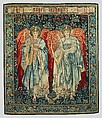Angels Praising (Angeli Laudantes)
In his drive to revitalize art and design in post– Industrial Revolution Britain, William Morris advocated that creators and practitioners understand their materials and utilize them according to their strengths: “Never forget the material you are working with, and try always to use it for doing what it can do best.” In this way, one could be truly fulfilled, artistically. For Morris, tapestries epitomized the purity of medieval craftsmanship. Championing his idealized vision that “the noblest of the weaving arts is Tapestry, in which there is nothing mechanical: it may be looked upon as a mosaic of colour made up of dyed threads,” Morris created the Merton Abbey Tapestry Works in 1881, in Surrey, just outside London. Perhaps contrary to Morris’s principles, this tapestry is based on a design Edward Burne-Jones originally intended for stained glass; it was Morris’s frequent collaborator, John Henry Dearle, who reworked the figures against a millefleur ground to create a tapestry cartoon.
Due to rights restrictions, this image cannot be enlarged, viewed at full screen, or downloaded.

